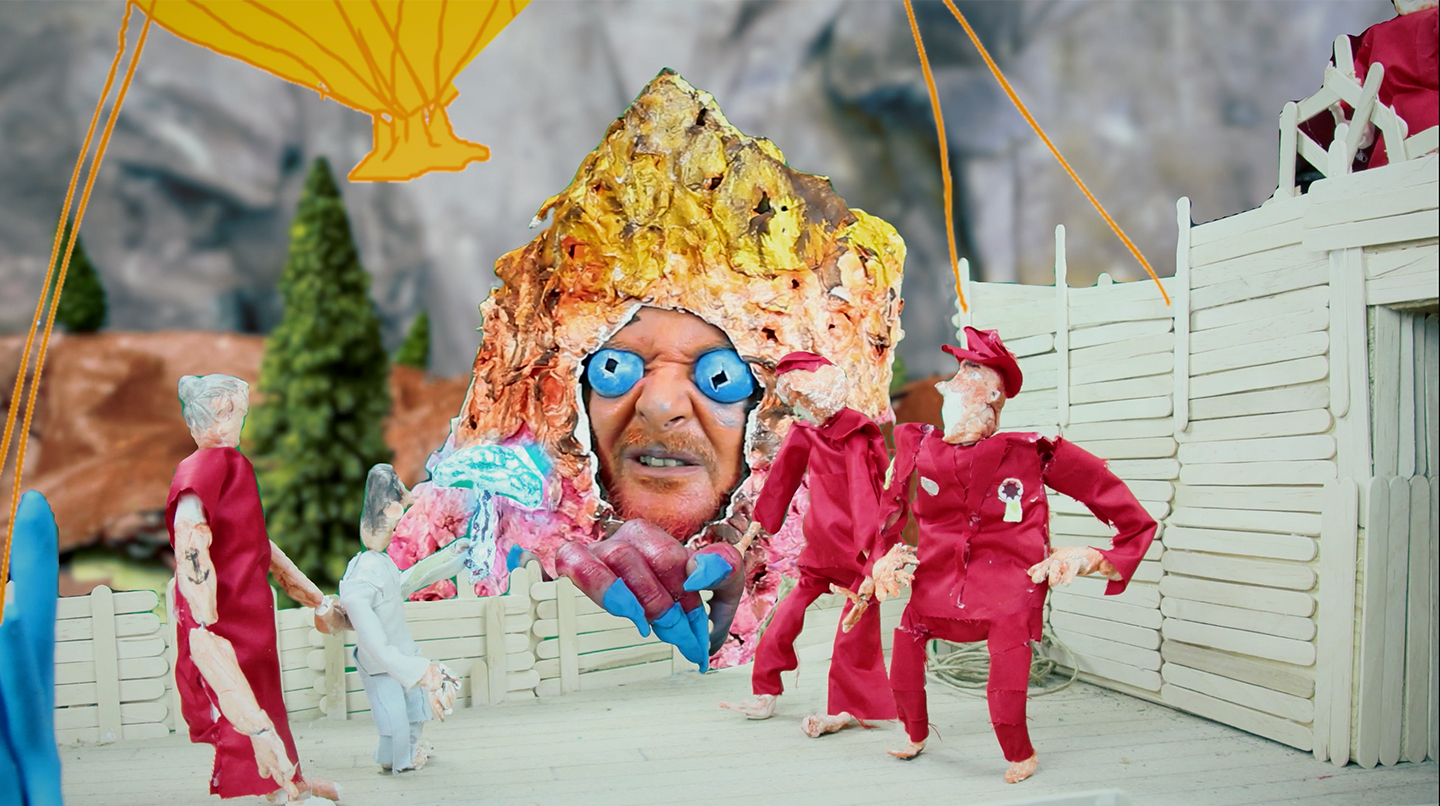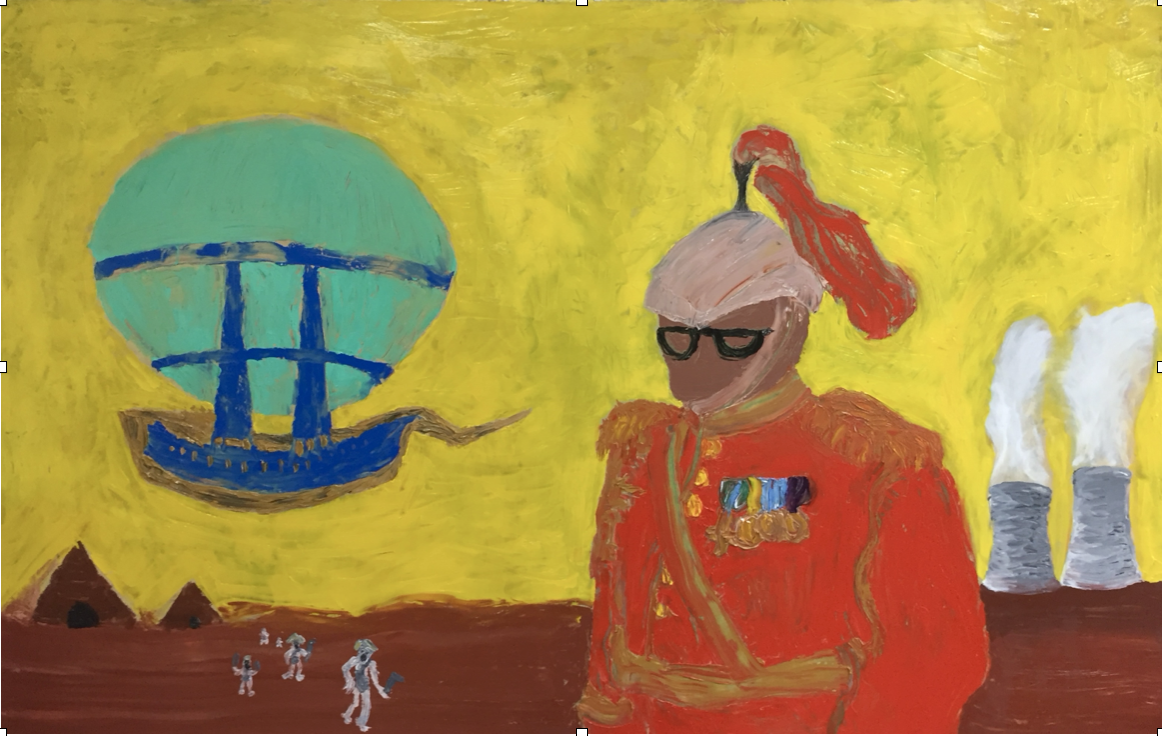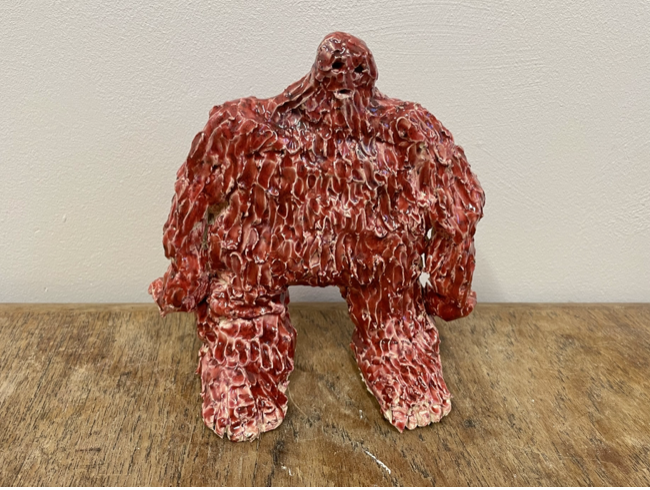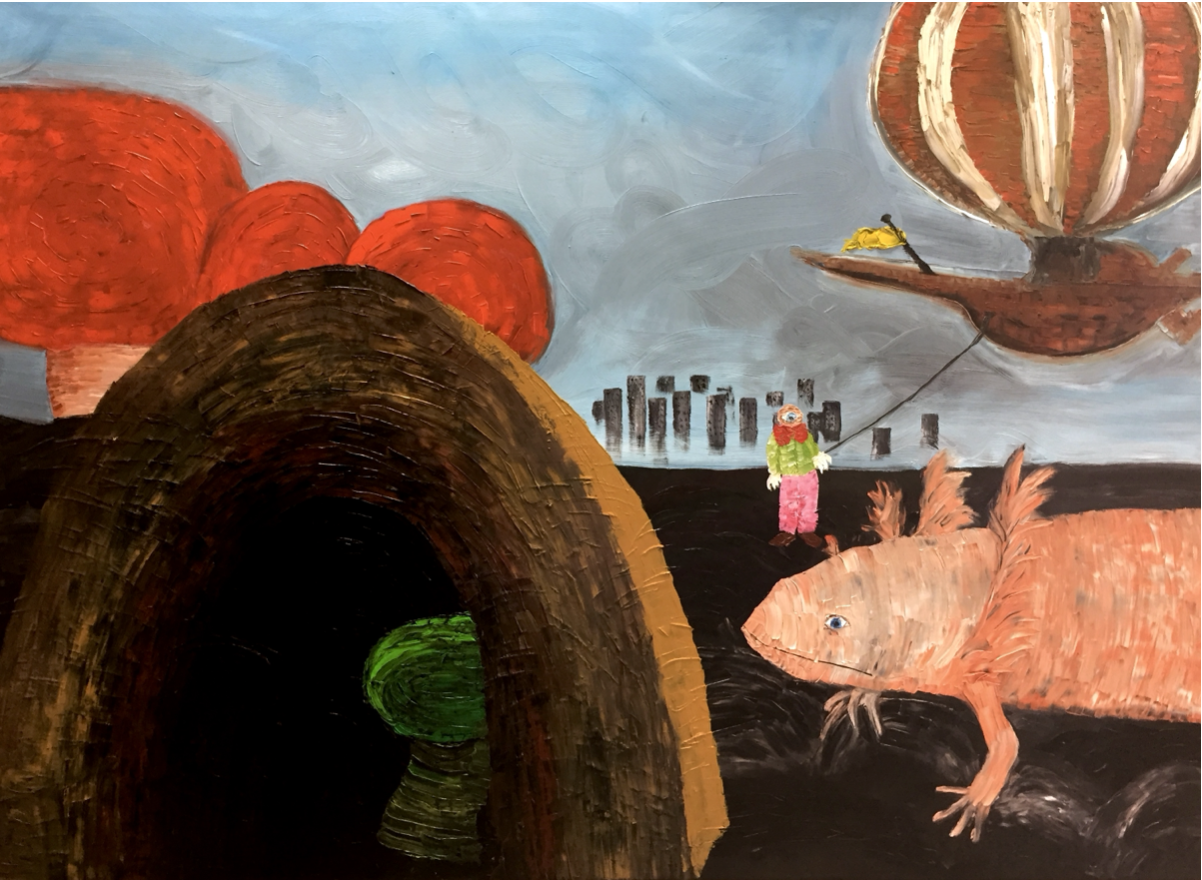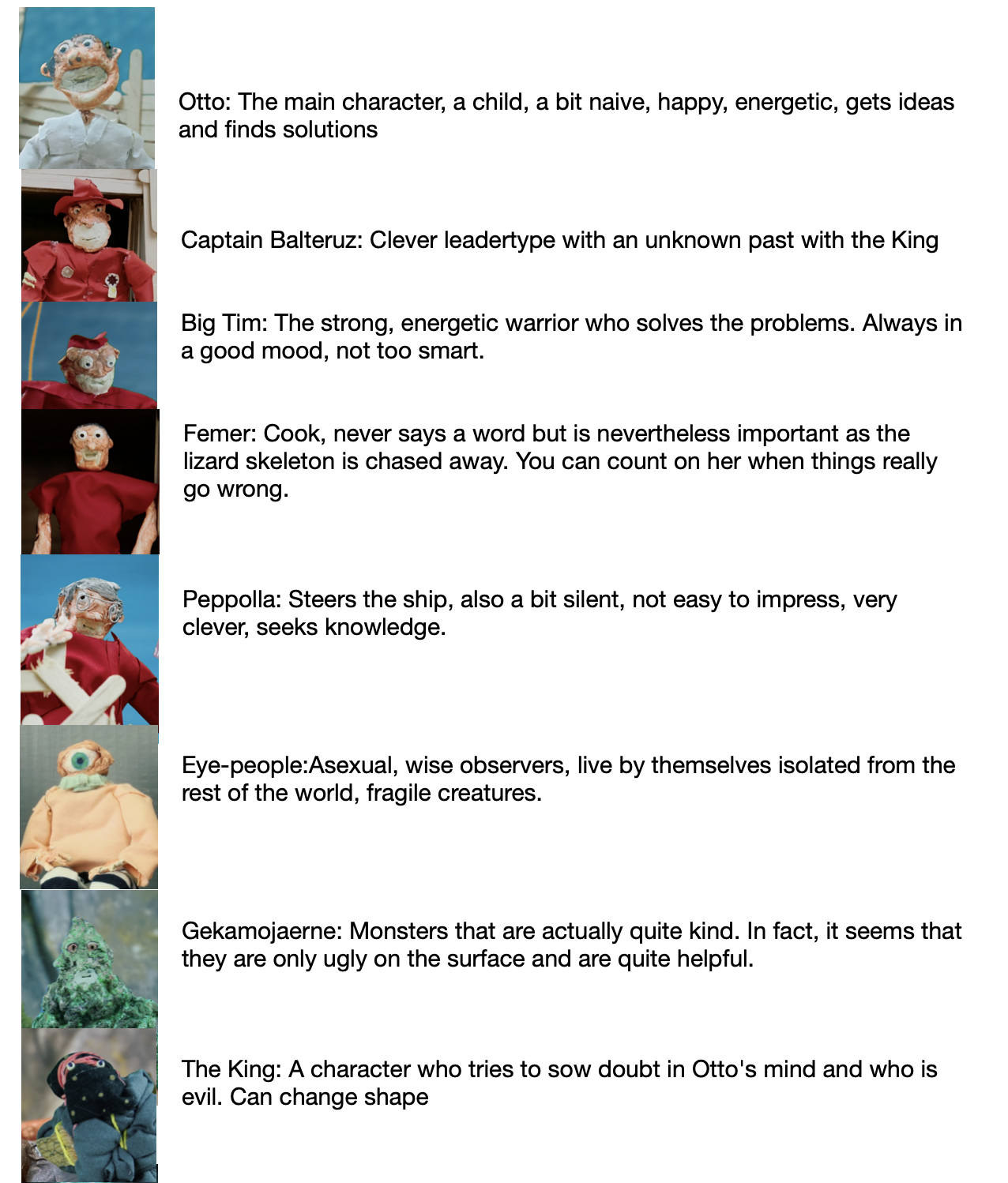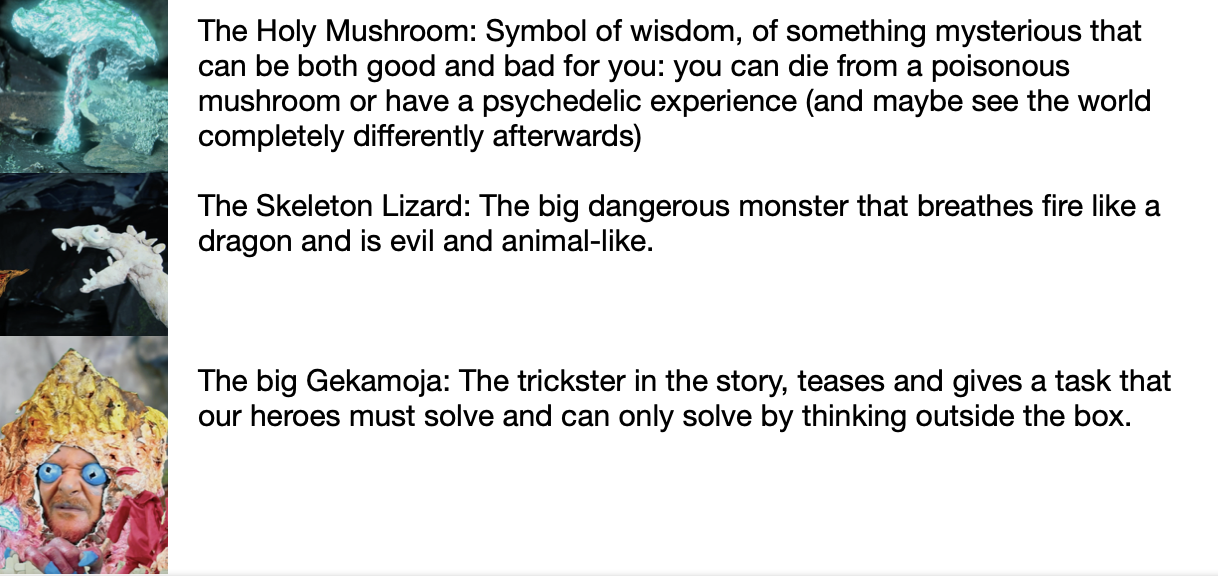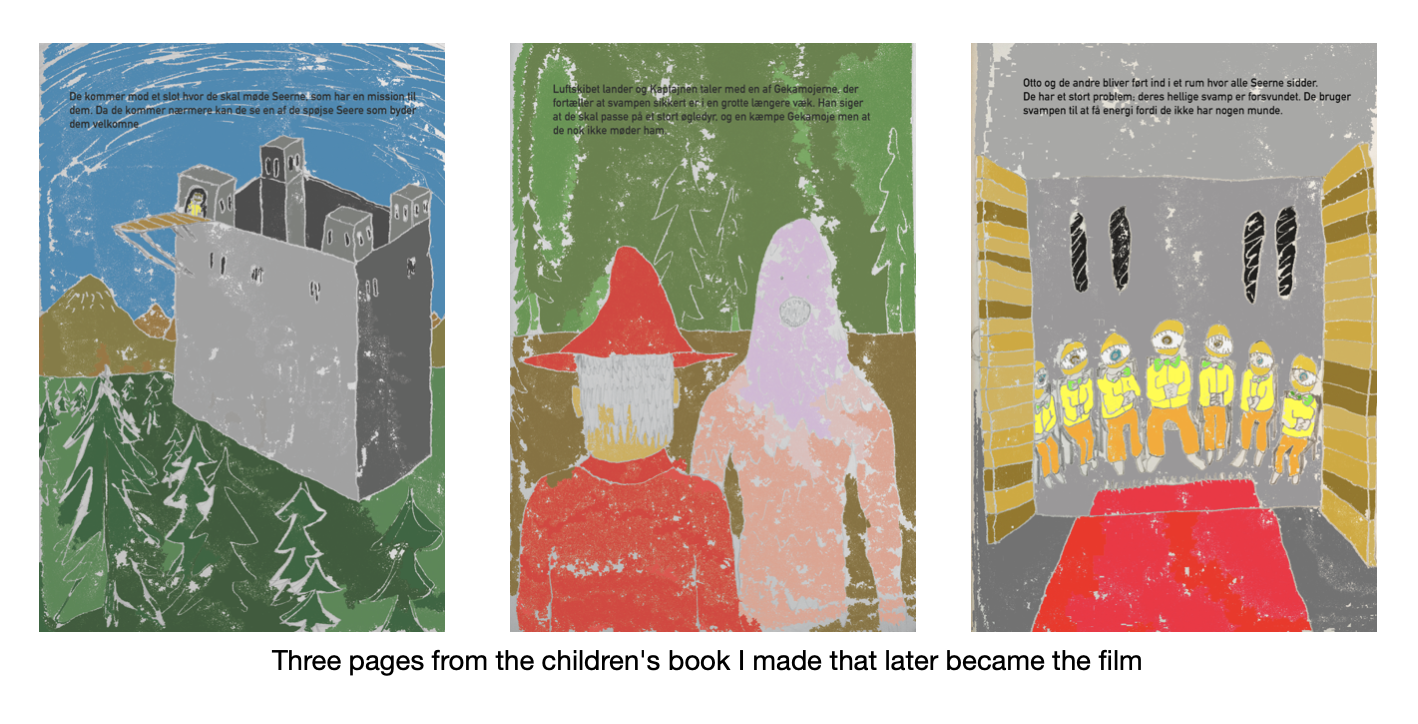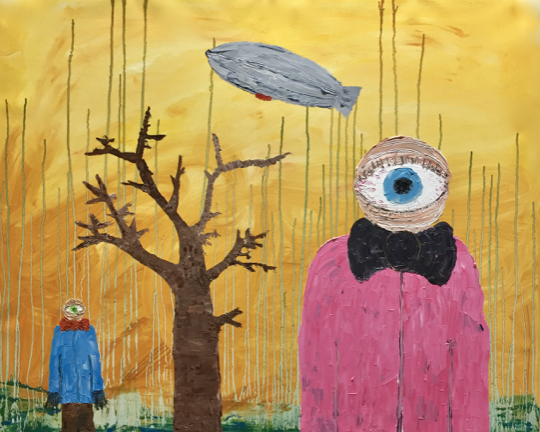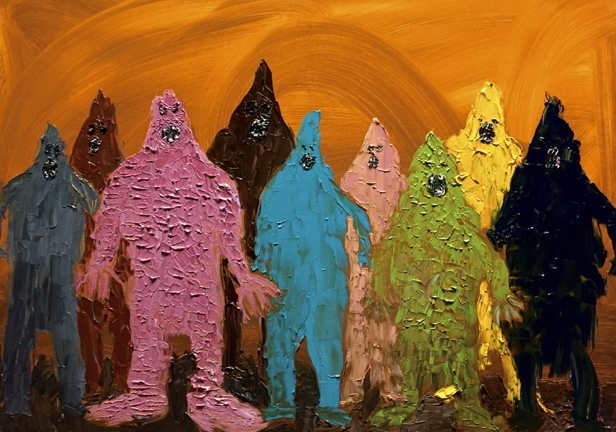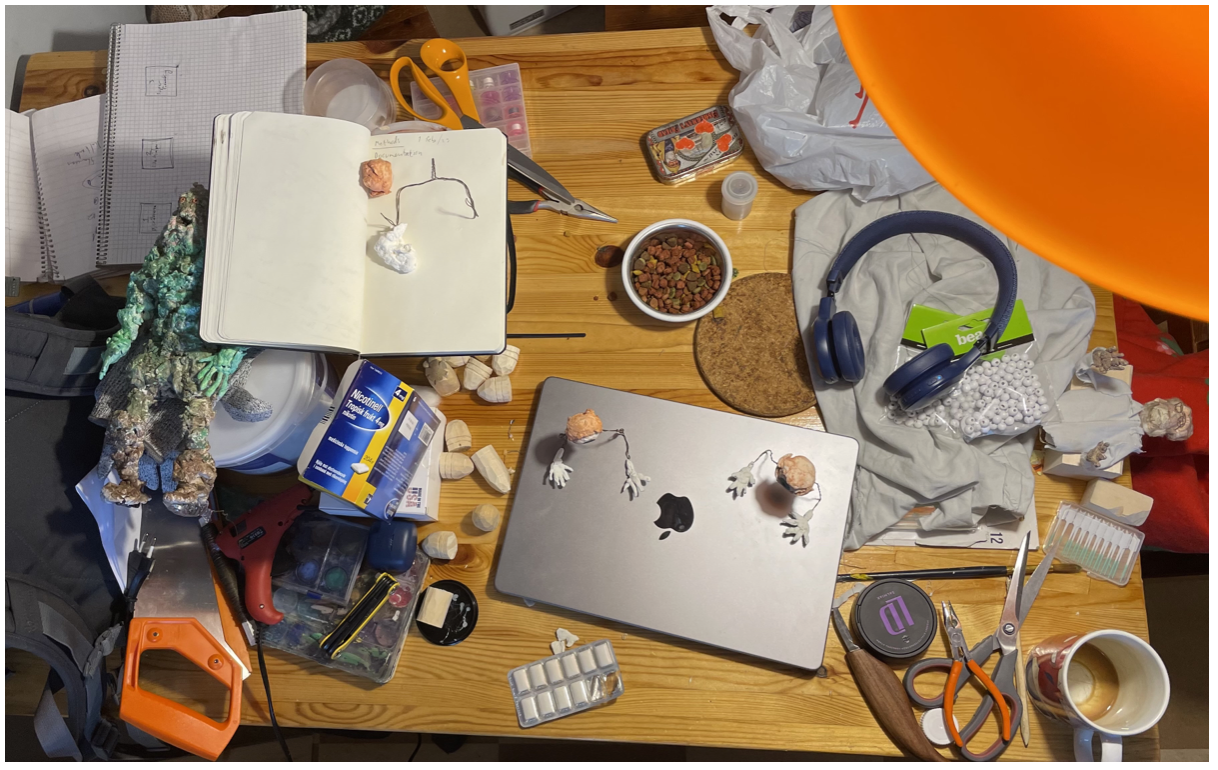Rasmus Albertsen has just finished the film: "The Holy Mushroom" and I have a lot of questions. The film is about a boy, Otto, who gets a mission go on a journey to find a mushroom in one of his dreams. Otto gains consciousness on a airship, but then there is a so-called "dream storm" which Otto luckily dreams away. The crew of the ship and Otto meet some eye-creatures who give him the mission to find the holy mushroom. The mushroom is guarded by a large fire-breathing skeletal lizard, but Otto and the others complete the mission in the end. Rasmus has written the script for the film, which is based on a children's book he made a few years ago. I want to talk to Rasmus about his views on animating, about how the story came to be, about Rasmus' relationship with nostalgia - and - about ugly animation.
But my first question is how did you come up with the story of The Holy Mushroom and why a mushroom?
It was a longer process; after taking an MFA in 2010, where I had been making video art throughout my studies, I started painting and found a huge source of inspiration in a 70s encyclopedia, which I flipped through from start to finish. From the encyclopedia I sampled interesting photos, which I put together and painted after. So it was a kind of collages, you could say, where I painted after the images that arose. Gradually, a kind of story formed in the paintings, which I have boiled down to the story of The Holy Mushroom. I show some examples of my paintings and ceramics, later in the text, and below is the painting Captain Balteruz's last voyage, which I consider to be my first
painting (aside from a number of somewhat half-hearted attempts at painting). This painting has laid the groundwork for several years of work for me, both because of the way I painted it and because of its narrative style, - I find the narrative in the painting as well as its title interesting. So the figure Baltheruz actually came first, but I have had other middle-aged "grumpy" men on a voyage of discovery in previous projects. However, Balteruz has evolved over time to not be particularly grumpy. I felt like gathering the story of Baltheruz, and that world, into one story. It developed into a children's book that I illustrated. This book then became the basis for my film script.
I think it is actually very human to try to find meaning in different things that are not necessarily connected, and when I have sat in my studio and contemplated on some of my paintings, I have sometimes seen them as a series where there was some sort of tale. Now I have sat down and made the story about how it all fits together in that world.
The fact that it is a mushroom that the boy Otto has to find, gave me some mixed emotions. I began to imagine children who have seen the film going out to find mushrooms, and finding some poisonous mushrooms that they then get sick from eating. For a while I thought that it was better if he found a holy hat. But, after a lot of thinking, I came, after seeing Elsa Beskow's drawings again, where there are lots of poisionous mushrooms, that hopefully it is an excessive concern I have had. One can also argue that parents have a duty to tell their children that poisonous mushrooms should not be eaten. You could also argue that I worry too much about things that might happen.
But as for why it is a mushroom, I think there is something a little dangerous, perhaps something a little forbidden about mushrooms. They can be fatally poisonous and others can provide a psychedelic experience. So it has some significance in the film in the way that it's not just a random holy hat they have to find. It gives, you could say, a little extra to the film - an extra dimension, I hope. It is also important that it is something natural that it is not an exhaust pipe that they have to find. I think it makes more sense that it is precisely a mushroom, because it all takes place inside Otto's dream and his consciousness.
How else has your work with painting and ceramics influenced the film?
Apart from the fact that it was from there that I got my ideas for my graduation film, I especially think that the aesthetics is something that I have taken with me into my animation films. I work intuitively with materials and it always ends up being quite colorful. I don't sit and make everything nice and "perfect" and maybe also have a patience issue (which I turn to my advantage, I think). As long as things last and my ceramic figures are not completely cracked, I'm sort of happy. I also don't sit and study proper correct technique for technique's sake. It has both advantages and disadvantages, of course: when you don't know the rules, something very original and unique can come out of it, or it can completely fall through the cracks and just be really bad.
But I'm pretty sure that over time I've gotten better at the more artisanal aspect. Of course, I took that with me into the work on the film. It has also made a huge difference that I have experience in building things in my studio, so even though it initially doesn't have much to do with my art, it has nevertheless become part of my practice, e.g. a I have built some small coffee tables from euro pallets, for example. Those things have helped a lot in the construction process for the scenography and figures; that I have some experience in building things, but of course ceramics and painting in particular are important. I have built a ship for the crew and Otto out of popsicle sticks which probably would have turned out less well if I had built it without any experience. Here I think in contrast to sitting in front of my computer and editing video as I did before.
What about your work with video art and its influence on your animated films?
I haven't made a lot of animated films, but I was quite active in video art for a number of years. It was very influenced by surrealism I think. It was often with a kind of Sisyphus theme mixed with a bit of humor, and often you ran the video in a loop and made sense that way - that is, by the fact that it all repeated itself.
But it's clear that it's an invaluable experience when I now make animated films, it all kind of merges together with video, sculptural elements, painting, building things and then stop-motion animation.
What is important to you in your animation and your animated films?
It has to be punk, DIY and fuck it all when it doesn't turn out perfect, because it doesn't have to be perfect. I think in punk music there's a lot of the same attitude - after all, the Sex Pistols went into a studio and recorded their music. I just mean that they weren't so much "fuck it all" that it all fell apart and they said fuck you to record an album. They wanted to convey something other than niceness, but there was still something that pulled in the other direction - precisely the niceness . Well, but to stay in this comparison: The result with the Sex Pistols was raw music, by musicians who, at least on one level, were bad musicians - or rather: technically they were bad. But it was about something other than technique. As it does for me, it is something else that is more important than that it is nice and that there are perfect and proper animations.
Moreover, it is important to me in my animated films and art in general, like this very appropriate quote from Pippi Longstocking, where she is asked whether she can play the piano: "How am I supposed to know when I never tried?" I really feel that it's all about making do with what you have. You don't need the world's most expensive equipment for your film, or for your music etc. Get something out of what you have.
So, now to answer the question: I think it is important that you can feel the joy I have in animating, building characters, scenography and coming up with stories. But the most important thing is rather that it is full of pleasure for me to make my projects and I hope that shines through to the viewer.
Do you work within any special themes in general?
I think the paintings, sculptures and films I make are quite naive and a bit grotesque. I've been thinking about my titles for artwork, where I often try to find something universally human, or again, something with archetypes mixed into it. As an example, I have had quite a few paintings where two people are fighting, and called them things like "Eternal battle" and the like. But it must be said that I don't think titles are that important, so often it just becomes something stupid on purpose such as "A crazy man", "Happy dog" or something else very simple and slightly silly.
By "themes" I mean that I work a lot with archetypes, but in a slightly twisted and, again, naive approach. With "archetypes" I think of legendary figures in particular and the things that recur in human stories, i.e. not Jung's theories about archetypes, which I am not very familiar with. I think I am somewhere in some self-invented myths.
What archetypes are there in "The Holy Mushroom" and what do you think about them?
There is, for example, the big Gekamoja, which is a monster that honors agreements and lets Otto and the others travel on after they have solved the Gekamoja's task. Here I come to think of Udgårds-Loke, from Norse mythology, where he bets with Thor and his entourage whether they can pass three tests. Here, Udgårds-Loke tries to trick them, but keeps his word in the end, and lets Thor and the others travel back home. This cunning and duplicity fascinates me. Now it's not because I invented the great Gekamoja with Udgårds-loke in mind, but I can see the similarity now here afterwards.
The king that Otto meets in the forest who is also a kind of trickster like Loki, in Norse mythology. You meet the king more in an upcoming second part, where you also see him change shape, as Loki did, among other things, but is still made of the same fabric remnants as in the first part. The Trickster type again goes all over the world in folklore and superstition. The trickster is a figure who teases and tricks both people and gods. And it is the trickster that fascinates me the most.
The great Gekamoja also has a large "lizard skeleton" as a pet that spews fire - i.e. a kind of dragon, which is also described in Norse mythology. Here, it's just the Midgard Serpent spewing poison. These kinds of monsters recur in most ancient mythologies.
But the fact that a character is only evil, or only good, as in Disney's films in particular, is quite silly and very caricatured. I find it much more interesting when there is a greater depth to a character.
I find archetypes deeply fascinating in folklore and superstition, so what do they tell us about ourselves? It is something that repeats itself in all cultures.
I think these figures are a kind of archetypes in my myth here:
What is your animation process like?
I am quick to animate and have calculated that I can make approx. 10 seconds a day, which you probably also expect to be able to do at the big professional stop-motion studios. The difference between me and the big studios is that my animations look like they do; crudely animated and like it's all about to fall apart. In addition, I divide the process into smaller parts so that it does not become unmanageable. Here I am thinking of the whole film and the different parts; i.e. construct puppets first, one at a time, and then scenography: build a smaller landscape, one at a time and so on. Each scene is divided into manageable moments because otherwise it becomes too overwhelming and unmanageable.
I may seem disorganized in my work process, but in reality I have worked out when to do the various things and which order makes the most sense. It is quite new for me to work in this way, where previously I would not have prepared nearly as much at all. I would rather have let the story develop little by little, and see where it all went. It's really something I take with me
the education, this method of preparation and extent which I will certainly do again. However, I have always been disciplined in my art, I would say.
But, in general, you can say that I use my lack of perfection skills to my own advantage, i.e. that I turn my shortcomings into something good. Not so much patience turns into a charming and rough animation. I didn't really think much about the different characters' movement patterns in my preparations, here the intuitive comes into the picture. I know how Big Tim thinks and moves by constructing him and building him myself, and don't have to write a lot down and prepare it. Now I also only have myself to think about in terms of preparations, so if I worked in a group it would be a different matter I think.
What sources of inspiration do you have?
The films I am most inspired by are of somewhat older date. I saw many of them as a child in Denmark. I was super fascinated by “Fraggle Rock” (Jim Henson 1983-1987) with especially traveling Uncle Mac who is on a journey of discovery in the real world. It made a big impression on me. Besides that, there are many different sources of inspiration that I can think of. When I moved to Sweden in 2005, I was introduced to several films and artists. Of the Swedish sources of inspiration, I think in particular of "Dunderklumpen" (1974, Per Åhlin) "Skrotnisse och hans vänner" (1985, Lars-Åke Kylén and Jan Lööf) and "Resan till Melonia" (1989, Per Åhlin) Also of the artists Johannes Nyholm with “Dockpojken” (2008) Peter Larsson “Människorna och valen” (2008) as well as Nathalie Djurberg (I can't name a specific work as all the ones I've seen have been fantastic), all three above are stop-motion animation.
In addition, there is "Flåklypa Grand Prix" from Norway (Ivo Caprino, 1975), and "Crash" from Denmark (Carsten Overskov, 1984, live action), which is about a boy who receives a visit from space in his room and travels into space with his room like a spaceship. "Benny's Bathtub" (1971, Flemming Quist Møller), which in Denmark is a very well-known cartoon, is about a boy who finds a tadpole, which takes him into the sea to, among other things, some skeleton pirates and a big angry crab.
Something that is common in many of my sources of inspiration is probably that there is a travel theme. I myself have traveled quite a lot in my life and lived in many places, and find it difficult to settle in.
I sometimes find the more modern stop-motion films a bit strained and sometimes think that it could just as well have been made as a 3D animation film. It will be too perfect. Here I would mention a movie like Pinocchio by Guillermo del Toro, which is too well made. You can hardly see that it is all made by hand, the only thing you can think is "no, how incredible that it is so perfectly done". One can compare it to a photorealistic landscape painting; what should I do with it? It's great that you have the technical skills, that's incredible - but what's on your mind? Where is the creativity, imagination and art?
What is non-perfection to you?
In my case, it is a joy in the material I work with, by constructing with modeling clay, steel wire, paint, chicken wire, etc. which I hope comes across to the audience. I actually think it's funny that you can see the steel wire itself, in perhaps especially the lizard, and in some of the other figures, for example after some of their fingers have fallen off. Perhaps the nostalgia is rather a by-product of my imperfect way of working. It is not on a theoretical level that I aim for the imperfect, but rather that I love the material, the fact that it gets worn and you can see glue on the characters' clothes etc. But exactly where the limit goes between the perfect and the imperfect is really hard to answer. In theory, I could just have two pieces of wire moving around a pile of clay, but that's not where I think there's anything interesting. But when is it good? Where is the exact limit?
Perhaps it is like this: it's ok to be slobby with the material, but technical things, (here I am thinking of e.g. editing and post-production) is not ok: above you can see a film still from "The Holy Mushroom" where I try to illustrate this. Here you see steel wire in a skeleton lizard, and next to it, a technical sloppiness has occurred and you can see its eyes in smaller size next to it. It's not okay with the eyes, but the fact that you can see the wire is okay (although I'm a bit in doubt about the wire, now that I think about it again, maybe I should have done it "better") But I think it's about, after all, taking it seriously, one might say, i.e. it must be thoroughly worked through.
Where is the limit when the imperfect becomes bad?
Yes, I said at one point that my animated film was badly made. But I don't think the movie is bad. It's a weird point that I'm having a hard time figuring out where it is exactly. Sometimes I think about the things I make partly look like they could be made by a child, but in that case a very insistent and stubborn child, because, well, it's not technically difficult, but you can see I have spent time and thought on what I do - even if it is primitive and simple, I think. I don't know if I'm exaggerating when I describe my film as poorly made, or if I'm just very self-critical, but one thing is certain, and that's that the characters themselves are a little too poorly made and can't be animated that much, without going completely broken, which is a problem.
Today, people talk about a kind of retro-revolution where popular culture uses nostalgia as a tool to reach the consumer's unformulated dreams. You who work with, and are interested in, nostalgia, how do you feel about nostalgia being used like this?
The films I mentioned further up give me a special appreciation of their craftsmanship - but - in these cases too, it is very imaginatively made. In these times of AI and so on, I/we feel a longing for something real and perhaps safe and uncomplicated in our uncertain world. And, a nostalgic expression can be an answer to this. Here I share an approach with, for example, advertising people who consciously use nostalgia as a way of creating some positivity around a brand. The difference is that I don't exactly use it as a manipulative grip; I didn't make my film out of a calculating desire for people to like it more because it is old fashioned. On the contrary, I'm probably idealisticly
searching for authenticity and do not see my audience as consumers who have to buy my product, but on the contrary, the audience itself looks for the good art.
But I have also always been critical of the fact that we are bombarded with advertisements for everything. It's pure manipulation. The fact that the advertising agencies now saw a lot of nostalgia in their advertisements is a bit silly, I think. But apart from commercials, I come to think of the series "Stranger Things", which I think is a good example, but where I felt that it was just like a carefully thought-out product, where I was the target audience, a lot because of my upbringing in the 80s , which made me not want to watch the series. But then again, there are probably many movies and series that started like that, if not most. I just think it was far too obvious in "Stranger Things". Maybe I think too highly of myself, but I don't like being the target audience in such a clear way as I felt with "Stranger Things". I get thoughts that "they mustn't believe me they can do the math".
Who "they" are, are some faceless bureaucrats who think they are creative and want to make a lot of money from stupid consumers.
In my own case, I don't use nostalgia in that way, that is, as a kind of sales trick, but rather because I love that aesthetic and that way of doing things. I also got music by the musician Viktor Sand, which I think fits the film's expression very well. You can also argue that the music is a bit 70s-like.
Why are you making a children's film?
Mostly because it's a challenge and something new for me. I think my style might suit children's films well, and I am very much influenced by my upbringing in Denmark, where there is a slightly different approach to children's films and children's culture in general. Danish children's culture is generally a bit more overgeared and caricatured, with inappropriate jokes and adults drinking alcohol as a natural thing, for example. The Danish children's culture is more devil-may-care, while it is more sensitive in Sweden.
I can think of a contemporary example like the Danish "Onkel Reje" (Uncle shrimp) who, however, succeeds in making certain people (who have found inspiration from the USA and QAnon) in Denmark angry because of his series about "Onkel Reje and his heavy band", which had little elements of satanism, however with a strong irony and besides that he was accused of being a pedophile. Uncle Reje received threats, a frenzy began against him and it ended with him calling in sick. Now he's back, though, and you can still go to YouTube and watch the videos for "I don't like to shower", "Fart, fart, fart" and "Monster mega heavy metal".
After all that has been said, I want to say that it is with mixed feelings that I am making a children's film after it dawned on me that most animation is of course for children (I don't mean that it goes without saying, but just that it is a fact that most animation is made for children) I don't want to go with the flow, but think that my graduation film here can also be seen and enjoyed by adults, I hope.
What do you think about companies like Disney and Pixar's animated films?
Boringly made and soulless, if I may be a bit crude. There isn't a misplaced computer-generated hair in the movies, which comes across as sterile in my opinion. I'm thinking of a comparison like this: almost all of us eat at McDonalds now and then, but it's not because it tastes really good - it's for other reasons; it's easy, fast and, not least, looks really inviting on their advertising signs. So what I want to say is: you can choose Disney if you like the easy and (perhaps) easily digestible.
It was a great pleasure talking to you Rasmus.
